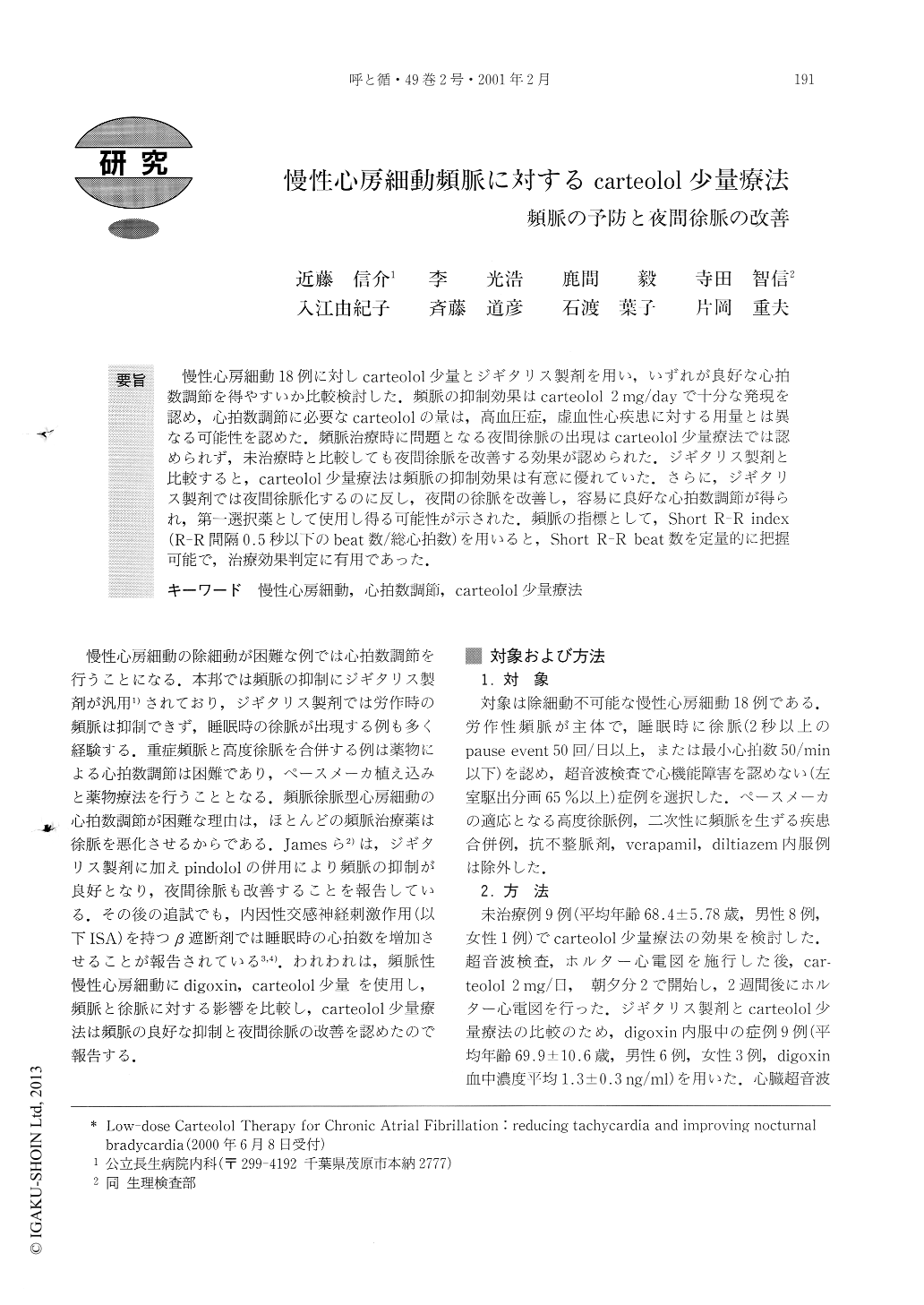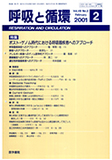Japanese
English
- 有料閲覧
- Abstract 文献概要
- 1ページ目 Look Inside
慢性心房細動18例に対しcarteolol少量とジギタリス製剤を用い,いずれが良好な心拍数調節を得やすいか比較検討した.頻脈の抑制効果はcarteolol 2mg/dayで十分な発現を認め,心拍数調節に必要なcarteololの量は,高血圧症,虚血性心疾患に対する用量とは異なる可能性を認めた.頻脈治療時に問題となる夜間徐脈の出現はcarteolol少量療法では認められず,未治療時と比較しても夜間徐脈を改善する効果が認められた.ジギタリス製剤と比較すると,carteolol少量療法は頻脈の抑制効果は有意に優れていた.さらに,ジギタリス製剤では夜間徐脈化するのに反し,夜間の徐脈を改善し,容易に良好な心拍数調節が得られ,第一選択薬として使用し得る可能性が示された.頻脈の指標として,Short R-R index(R-R間隔0.5秒以下のbeat数/総心拍数)を用いると,Short R-R beat数を定量的に把握可能で,治療効果判定に有用であった.
The purpose of this study is to compare the effects of low-dose carteolol and digoxin on heart-rate control in18 patients with chronic atrial fibrillation. Firstly, in 9patients without heart rate control treatment, 24-hourheart rate profiles were studied before (control) and 2weeks after low-dose carteolol treatment (1 mg twicedaily), using 24-hour ambulatory Bolter ECG. Secondly,9 patients under conventional digoxin treatment for thepurpose of heart rate control were studied in the samemanner. We switched the conventional digoxin therapyto low-dose carteolol (1mg twice daily) therapy and 24-hour ambulatory Holter ECG was performed againafter two or four weeks.
Compared with the controls, low-dose carteolol therapy improved mean HR (p<0.01). maximum HR (p<0.0001), maximum R-R interval (p<0.05) and pauseevent (p<0.05) (Table 1, Fig. 2, 3). Minimum HR increased slightly, but it was not significant. Comparedwith conventional digoxin treatment, low-dose carteolol therapy improved minimum HR (p<0.01), maximum HR (p<0.0005), maximum R-R interval (p<0.05)and pause event (p<0.05) (Table 2, Fig 3, 4). Althoughthere was no significant difference of mean HR betweenthese two treatments, low-dose carteolol therapyreduced tachycardia and improved nocturnal bradycardia compared with controls and conventional digoxintreatment.
An irregular sequence of R-R intervals producesadverse hemodynamic consequences. One of the important purposes of heart rate control is reduction of excessamount of short R-R intervals. Since it was difficult toevaluate short R-R interval frequency by conventionalparameters, we created an original parameter, “Short R-R index”.
(Number of heart beats less than 0.5-sec.)/(Totalheart beats) (%). Using this parameter, we found thatlow-dose carteolol therapy is highly effective in patientswith many short R-R beats (Fig. 2). Furthermore, low-dose carteolol was better than digoxin in reducing theshort R-R beat number (Fig 4).
We concluded that low-dose carteolol therapy is moreeffective than conventional digoxin treatment on theheart rate control of patients with chronic atrial fibrillation.

Copyright © 2001, Igaku-Shoin Ltd. All rights reserved.


